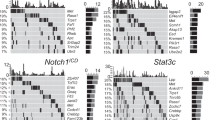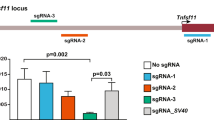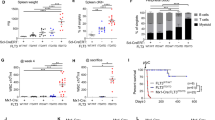Abstract
Knock-in models of tumor-specific chromosomal translocations can generate lethal mutations. To circumvent this, a new conditional gene fusion model has been developed (invertor mice) and exemplified with the Ews-ERG fusion oncogene. An ERG segment, flanked by loxP sites, was knocked in to an intron of the Ews gene but in an inverted transcription orientation and lineage-specific Ews-ERG fusion created by Cre-mediated inversion. This invertor method is a completely conditional approach, applicable to any gene fusion, to emulate effects of translocations found in human cancers.
This is a preview of subscription content, access via your institution
Access options
Subscribe to this journal
Receive 12 print issues and online access
$259.00 per year
only $21.58 per issue
Buy this article
- Purchase on Springer Link
- Instant access to full article PDF
Prices may be subject to local taxes which are calculated during checkout


Similar content being viewed by others
References
Rabbitts, T.H. Nature 372, 143–149 (1994).
Look, A.T. Science 278, 1059–1065 (1997).
Bennicelli, J.L. & Barr, F.G. Curr. Opin. Oncol. 14, 412–419 (2002).
Crozat, A., Aman, P., Mandahl, N. & Ron, D. Nature 363, 640–644 (1993).
Rabbitts, T.H., Forster, A., Larson, R. & Nathan, P. Nat. Genet. 4, 175–180 (1993).
Corral, J. et al. Cell 85, 853–861 (1996).
Higuchi, M. et al. Cancer Cell 1, 63–74 (2002).
Smith, A.J.H. et al. Nat. Genet. 9, 376–384 (1995).
van Deursen, J., Fornerod, M., van Rees, B. & Grosveld, G. Proc. Natl. Acad. Sci. USA 92, 7376–7380 (1995).
Buchholz, F., Refaeli, Y., Trumpp, A. & Bishop, J.M. EMBO Rep. 1, 133–139 (2000).
Collins, E.C., Pannell, R., Simpson, E.M., Forster, A. & Rabbitts, T.H. EMBO Rep. 1, 127–132 (2000).
Forster, A. et al. Cancer Cell 3, 449–458 (2003).
Dale, E.C. & Ow, D.W. Gene 91, 79–85 (1990).
Roberts, C.W., Leroux, M.M., Fleming, M.D. & Orkin, S.H. Cancer Cell 2, 415–425 (2002).
McCormack, M.P., Forster, A., Drynan, L.F., Pannell, R. & Rabbitts, T.H. Mol. Cell. Biol. 23, 9003–9013 (2003).
Acknowledgements
This work was supported by the Medical Research Council. R.C. was the recipient of a Leukemia Research Fund Gordon Pillar Studentship, M.M. is the recipient of a fellowship from the German Research Foundation, and M.N.L. was the recipient of a Kay Kendall fellowship. We are very grateful to A. McKenzie for the frt-flanked PGK-neo clone. We would also like to thank G. King, A. Middleton and C. Pearce for animal husbandry and A. Lenton for the illustration work.
Author information
Authors and Affiliations
Corresponding author
Ethics declarations
Competing interests
The authors declare no competing financial interests.
Supplementary information
Supplementary Fig. 1
Targeting cassettes for invertor or knock-in cDNA cloning. (PDF 184 kb)
Supplementary Fig. 2
Strategy for construction of the invertor cDNA cassette. (PDF 212 kb)
Supplementary Fig. 3
Cassettes for knock-in of the Cre recombinase gene into targeting vectors for gene specific expression. (PDF 190 kb)
Supplementary Fig. 4
ERG cDNA sequence for invertor knock-in targeting clones (PDF 68 kb)
Rights and permissions
About this article
Cite this article
Forster, A., Pannell, R., Drynan, L. et al. The invertor knock-in conditional chromosomal translocation mimic. Nat Methods 2, 27–30 (2005). https://doi.org/10.1038/nmeth727
Received:
Accepted:
Published:
Issue Date:
DOI: https://doi.org/10.1038/nmeth727
This article is cited by
-
The construction of transgenic and gene knockout/knockin mouse models of human disease
Transgenic Research (2012)
-
Investigating human leukemogenesis: from cell lines to in vivo models of human leukemia
Leukemia (2008)
-
MLL gene fusions in human leukaemias: in vivo modelling to recapitulate these primary tumourigenic events
International Journal of Hematology (2008)
-
Maximizing mouse cancer models
Nature Reviews Cancer (2007)
-
Adopting the good reFLEXes when generating conditional alterations in the mouse genome
Transgenic Research (2007)



